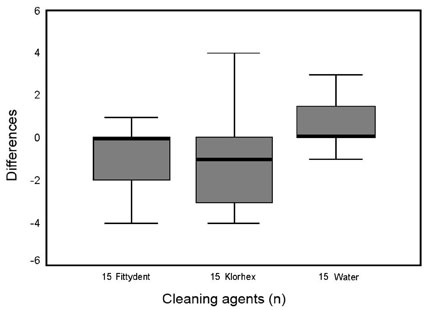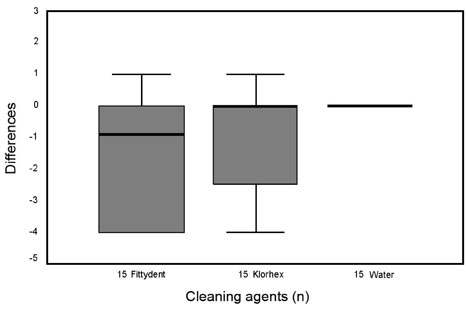Yonsei Med J.
2008 Aug;49(4):647-654. 10.3349/ymj.2008.49.4.647.
Effectiveness of Different Cleaning Agents against the Colonization of Candida spp and the in Vitro Detection of the Adherence of These Yeast Cells to Denture Acrylic Surfaces
- Affiliations
-
- 1Department of Prosthetic Dentistry, Faculty of Dentistry, University of Gazi, Ankara, Turkey. dnalbant@gazi.edu.tr
- 2Department of Microbiology, Gazi University Faculty of Medicine, Ankara, Turkey.
- KMID: 1793202
- DOI: http://doi.org/10.3349/ymj.2008.49.4.647
Abstract
- PURPOSE
The aim of this study is to examine the effect Klorhex and Fittydent, which are used as cleaning agents on the adhesion of Candida on the surfaces of acrylic denture and palatal mucosa. In addition, ability of yeasts to adhere to acrylic strips was evaluated after applying these agents in vitro. MATERIALS and METHODS: Each group of 15 patients cleaned their dentures with either Klorhex or with Fittydent. The control group cleaned their dentures with water. RESULTS: It was found that 62.2% of the patients had colonies of Candida species on their palatal mucosa which was reduced to 51.1% after using these cleaning agents. The colonization rate with Candida spp on their dentures was reduces from 82.2% to 68.8% using these cleaning agents. The mean adhesion value of the Candida strains isolated from the acrylic strips were found to be 75cell/strip prior to applying the Klorhex and Fittydent and 37.5cell/strip and 15cell/strip after applying these agents, respectively. CONCLUSION: These results showed that Klorhex and Fittydent have a certain preventive effect on the colonization rate of Candida spp on the surface of these dentures, the palatal mucosa, as well as on the acrylic strips in vitro.
Keyword
MeSH Terms
Figure
Reference
-
1. Budtz-Jörgensen E. Etiology, pathogenesis, therapy, and prophylaxis of oral yeast infections. Acta Odontol Scand. 1990. 48:61–69.
Article2. Zegarelli DJ. Fungal infections of the oral cavity. Otolaryngol Clin North Am. 1993. 26:1069–1089.
Article3. Ellepola AN, Samaranayake LP. Adhesion of oral Candida albicans isolates to denture acrylic following limited exposure to antifungal agents. Arch Oral Biol. 1998. 43:999–1007.4. Nikawa H, Nishimura H, Hamada T, Kumagai H, Samaranayake LP. Effects of dietary sugars and, saliva and serum on Candida bioflim formation on acrylic surfaces. Mycopathologia. 1997. 139:87–91.5. Samaranayake LP, MacFarlane TW. An in-vitro study of the adherence of Candida albicans to acrylic surfaces. Arch Oral Biol. 1980. 25:603–609.
Article6. Samaranayake LP, McCourtie J, MacFarlane TW. Factors affecting the in-vitro adherence of Candida albicans to acrylic surfaces. Arch Oral Biol. 1980. 25:611–615.
Article7. Sheen SR, Harrison A. Assessment of plaque prevention on dentures using an experimental cleanser. J Prosthet Dent. 2000. 84:594–601.8. Nikawa H, Hamada T, Yamamoto T. Denture plaque-past and recent concerns. J Dent. 1998. 26:299–304.9. Kulak Y, Arikan A, Albak S, Okar I, Kazazoğlu E. Scanning electron microscopic examination of different cleaners: surface contaminant removal from dentures. J Oral Rehabil. 1997. 24:209–215.
Article10. Kulak-Ozkan Y, Kazazoglu E, Arikan A. Oral hygiene habits, denture cleanliness, presence of yeasts and stomatitis in elderly people. J Oral Rehabil. 2002. 29:300–304.
Article11. Hoad-Reddick G, Grant AA, Griffiths CS. Investigation into the cleanliness of dentures in an elderly population. J Prosthet Dent. 1990. 64:48–52.
Article12. Nikawa H, Hamada T, Yamashiro H, Kumagai H. A review of in vitro and in vivo methods to evaluate the efficacy of denture cleansers. Int J Prosthodont. 1999. 12:153–159.13. Persson RE, Truelove EL, LeResche L, Robinovitch MR. Therapeutic effects of daily or weekly chlorhexidine rinsing on oral health of a geriatric population. Oral Surg Oral Med Oral Pathol. 1991. 72:184–191.
Article14. McCourtie J, MacFarlane TW, Samaranayake LP. Effect of saliva and serum on the adherence of Candida species to chlorhexidine-treated denture acrylic. J Med Microbiol. 1986. 21:209–213.
Article15. Kaabachi O, Jemli B, Barguellil F, Boudabous A, Gargouri S, Amor A. Comparative study of adherence of five Candida species to polyvinyl chloride. Ann Biol Clin (Paris). 2001. 59:271–276.16. Costa Pires MF, Corrêa B, Gambale W, Paula CR. Experimenal model of Candida albicans (serotypes A and B) adheremce in vitro. Braz J Microbiol. 2001. 32:163–169.17. Kimura LH, Pearsall NN. Adherence of Candida albicans to human buccal epithelial cells. Infect Immun. 1978. 21:64–68.
Article18. Nikawa H, Nishimura H, Hamada T, Makihira S, Samaranayake LP. Relationship between thigmotropism and Candida biofilm formation in vitro. Mycopathologia. 1999. 144:125–129.19. Spiechowicz E, Santarpia RP 3rd, Pollock JJ, Renner RP. In vitro study on the inhibiting effect of different agents on the growth of Candida albicans on acrylic resin surfaces. Quintessence Int. 1990. 21:35–40.20. Conover WJ, editor. Some methods based on ranks. Practical Nonparametric Statistics. 1980. New York: John Wiley & Sons;213–343.21. Arendorf TM, Walker DM. The prevalence and intraoral distribution of Candida albicans in man. Arch Oral Biol. 1980. 25:1–10.22. Darwazeh AM, Al-Dosari A, Al-Bagieh NH. Oral Candida and nasal Aspergillus flora in a group of Saudi healthy dentate subjects. Int Dent J. 2002. 52:273–277.
Article23. Kuc IM, Samaranayake LP, van Heyst EN. Oral health and microflora in an institutionalised elderly population in Canada. Int Dent J. 1999. 49:33–40.
Article24. Sedgley CM, Samaranayake LP. The oral prevalence of aerobic and facultatively anaerobic gram-negative rods and yeasts in Hong Kong Chinese. Arch Oral Biol. 1994. 39:459–466.
Article25. Darwazeh AM, Al-Refai S, Al-Mojaiwel S. Isolation of Candida species from the oral cavity and fingertips of complete denture wearers. J Prosthet Dent. 2001. 86:420–423.
Article26. Sayiner A, Ozbakkaloglu B, Hilmioglu S, Inci R. Yeast colonization of mucosal linings in the elderly. Turkish J Infect. 1997. 11:137–140.27. Aytimur M, Surucuoglu S, Hilmioglu S, Aydemir S, Burhanoglu D, Saydam C. Investigation of oral Candida colonization in the elderly wearing complete denture. Turkish J Infect. 1997. 11:141–143.28. Alpoz AR, Hilmioglu S, Tasbakan MI. Oral carriage of Candida and association between Candida and dfs, DMFs scores in a group of 7-12 year-old children. Turkish J Infect. 1999. 13:169–172.29. Gökdal I, Kalkanci A, Paçal G, Altuğ Z. Candida colonization on the surface of orthodontic brackets and the adhesion of these strains to buccal epithelial cells. Mikrobiyol Bul. 2002. 36:65–69.30. Pires FR, Santos EB, Bonan PR, De Almeida OP, Lopes MA. Denture stomatitis and salivary Candida in Brazilian edentulous patients. J Oral Rehabil. 2002. 29:1115–1119.
Article31. Budtz-Jorgensen E, Bertram U. Denture stomatitis I. The etiology in relation to trauma and infection. Acta Odontol Scand. 1970. 28:71–92.
Article32. Dills SS, Olshan AM, Goldner S, Brogdon C. Comparison of the antimicrobial capability of an abrasive paste and chemical-soak denture cleansers. J Prosthet Dent. 1988. 60:467–470.
Article33. Ellepola AN, Samaranayake LP. Adjunctive use of chlorhexidine in oral candidoses: a review. Oral Dis. 2001. 7:11–17.
Article34. Lal K, Santarpia RP 3rd, Pollock JJ, Renner RP. Assessment of antimicrobial treatment of denture stomatitis using an in vivo replica model system: therapeutic efficacy of an oral rinse. J Prosthet Dent. 1992. 67:72–77.
Article35. Kulak Y, Arikan A, Delibalta N. Comparison of three different treatment methods for generalized denture stomatitis. J Prosthet Dent. 1994. 72:283–288.
Article36. Panagoda GJ, Samaranayake LP. A new, semi-automated technique for quantification of Candida adherence to denture acrylic surfaces. Mycoses. 1999. 42:265–267.37. Panagoda GJ, Ellepola AN, Samaranayake LP. Adhesion of Candida parapsilosis to epithelial and acrylic surfaces correlates with cell surface hydrophobicity. Mycoses. 2001. 44:29–35.
Article38. Waters MG, Williams DW, Jagger RG, Lewis MA. Adherence of Candida albicans to experimental denture soft lining materials. J Prosthet Dent. 1997. 77:306–312.
Article39. Millsap KW, Bos R, van der Mei HC, Busscher HJ. Adhesion and surface-aggregation of Candida albicans from saliva on acrylic surfaces with adhering bacteria as studies in a parallel plate flow chamber. Antonie Leeuwenhoek. 1999. 75:351–359.40. Nikawa H, Nishimura H, Makihira S, Hamada T, Sadamori S, Samaranayake LP. Effect of serum concentration on Candida biofilm formation on acrylic surfaces. Mycoses. 2000. 43:139–143.41. McCourtie J, MacFarlane TW, Samaranayake LP. Effect of chlorhexidine gluconate on the adherence of Candida species to denture acrylic. J Med Microbiol. 1985. 20:97–104.
Article
- Full Text Links
- Actions
-
Cited
- CITED
-
- Close
- Share
- Similar articles
-
- Adherence of Candida to complete denture surfaces in vitro: A comparison of conventional and CAD/CAM complete dentures
- In vitro study on the adherence and penetration of candida albicans into denture soft lining materials
- Biofilm-forming ability and adherence to poly-(methyl-methacrylate) acrylic resin materials of oral Candida albicans strains isolated from HIV positive subjects
- INHIBITORY EFFECT OF ANTIFUNGAL AGENTS INCORPORATED IN DENTURE LINING MATERIALS AGAINST CANDIDA ALBICANS
- Bactericidal Effect of the Aos Denti Germ for Denture Cleansing Effervescent Tablet against Oral Microorganisms



